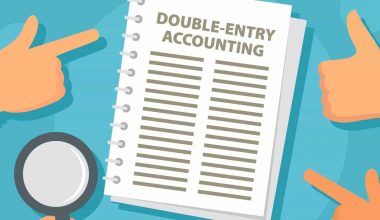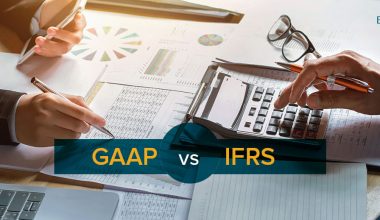When a company purchases products and services on credit from a supplier or creditor that must be paid back quickly, the accounting item is known as Accounts Payable (AP). On a balance sheet, it is listed as current liabilities. An AP department at a firm is in charge of making payments owed by the company to suppliers and other creditors. In this article, you will learn all about accounts payable including their examples, their process, what they are on a balance sheet, and a good comparison of AP and receivable. Let’s get started.
What Are Accounts Payable (AP)?
Accounts payable (AP) is a short-term debt and a balance-sheet liability in which a company owes money to its vendors/suppliers who have given the company with goods or services on credit. AP is also known as the department in charge of handling vendor invoices or bills and recording short-term debts in the general ledger (GL). Before providing payment to their vendors, the AP department would verify invoices against (buy) orders and ensure that the products or services were received.
What does Accounts Payable do?
The AP department’s role is to offer an organization financial, administrative, and clerical support: This team is in charge of overseeing the full accounts payable process. This is a vital function in the company’s accounting department, and it entails the coding, approval, payment, and reconciliation of vendor invoices.
Each account payable team member’s responsibility contributes to the improvement of the payment process and ensures that payments are only made on legitimate and accurate bills and invoices. A skilled and well-managed accounts payable staff can save your company a significant amount of time and money in the AP process.
With automation capabilities, AP teams may quickly select when to pay invoices (to prevent late fees or take advantage of early pay savings) and how to pay them (via paper check, ACH, or through virtual cards where you earn cash-back rebates). As a result, organizations gain greater control over their outgoing cash and can even change AP from a cost center to a profit center.
What Is the Accounts Payable Process?
Before making a vendor payment, the AP department will complete a set of procedures. Because of the magnitude and volume of transactions at any given time, guidelines must be established.
The procedure entails the following steps:
#1. Receiving the bill
If products were purchased, the bill assists in determining the quantity received. During this time, the bill’s authenticity can also be determined.
#2. Review bill details
Verify that the bill includes the vendor’s name, authorization, date, and specifications that have been checked and match the purchase order.
#3. Updating records once the bill is received
Accounts in the ledger must be updated depending on received bills, and an expense entry is frequently required. With the approval hierarchy tied to the bill value, managerial approval may be required at this step.
#4. Making timely payment
All payments on bills should be executed before or on the due date agreed upon between a vendor and a purchasing business. The necessary paperwork must be prepared and checked. The information recorded on the cheque, the vendor’s bank account information, payment vouchers, the original bill, and the purchase order must all be reviewed. A managerial approval may also be necessary at this time.
Internal controls should be included in the accounts payable process to ensure the safety of a company’s cash and assets.
- Prevent paying a fraudulent invoice
- Prevent paying an inaccurate invoice
- Prevent paying a vendor invoice twice
- Be certain that all vendor invoices are accounted for
Accounts Payable Examples
AP includes business-to-business billing. Your business must pay another business for the items or services it offers. These are several examples involving accounts payable, they include:
#1. Cleaning services
Cleaning services are one of the examples of accounts payable. AP might be seen when Company A employs Company B to meet its cleaning needs. In this case, Business A must pay Company B on a regular basis in exchange for timely and dependable cleaning services.
#2. Staff uniforms
This is one of the examples of accounts payable is when a company contracts another company to make its employees’ uniforms. This is an example of a recurring or ongoing company expense. Further orders will be required due to staff turnover and lost or damaged uniforms. When Business B receives a new order, it invoices Business A, and Company A’s accounts receivables department handles the payment.
#3. Office Supplies
To guarantee that they never run out of crucial supplies, many businesses buy in bulk and set up recurring purchases based on usage frequency. To ensure effective productivity, these business owners frequently have pending payments to their office supply suppliers.
#4. Sanitation
Many businesses hire other businesses to transport away their rubbish and recyclables. These services are usually provided on a weekly basis. This is also one of the good examples of accounts payable.
What Are Accounts Payable and Receivable?
Accounts receivable (AR) and accounts payable (AP) are fundamentally diametrically opposed. Accounts payable are the funds owing to vendors, whereas accounts receivable are funds owed to the company, generally by consumers. When one company conducts a credit transaction with another, one will record an entry to AP on their books, while the other will record an entry to accounts receivable.
Accounts receivable vs. accounts payable: What’s the difference?
- Classification
- Offset allowances
- Audits
The accounting methods for accounts receivable and accounts payable are very similar. The essential contrast is that accounts receivable refer to money that is expected to enter the organization, whereas accounts payable refers to money that will soon leave the company. Additional distinctions between accounts receivable and accounts payable are as follows:
#1. Classification
AP is a current asset account that reports money that is expected to enter the organization soon. Accounts receivable are a type of current liability account that describes money that is about to leave the company.
#2. Offset allowances
Accounts receivable, but not AP may have a running amount known as an offset allowance. Offset allowances are designed to account for the possibility that some accounts receivable sums will never be paid. Accountants refer to these as “doubtful accounts.” An offset allowance is the amount of money that the company stands to lose if questionable accounts do not pay their invoices. The corporation will incur a loss, which will have an impact on its total bottom line.
Accountants and bookkeepers may not construct offset allowances for AP. If the corporation creates an offset allowance for debts it (the company) owes, it implies that the company does not intend to pay its bills. This behavior is in violation of several widely accepted accounting principles (GAAP) that govern business finance.
#3. Audits
Auditors examine both accounts payable and receivable to ensure transparency and honesty, but they look for different things in each ledger.
- While auditing accounts receivable, they ensure that each ledger item corresponds to real-world invoices. They also seek questionable accounts and bills that are unlikely to be paid. They check to see whether a company’s bookkeepers are inflating the company’s net value by reporting future income that will never be realized. If a company’s clients appear unwilling to pay their invoices, their sum must be transferred from accounts receivable to current expenses. Auditors also certify that all AP are correctly listed by the company.
- Auditors seek the contrary when auditing AP—companies might exaggerate their net worth by deleting bills from AP. This effectively conceals known obligations from the company’s shareholders, creditors, and potential investors.
Why Automate Accounts Payable?
Every business receives bills and pays vendors. Nevertheless, manually processing these invoices and paying payments takes a long time and is very costly. The typical cost of manually processing an invoice is $12-15, with an additional $5 for payment by paper check. Manual AP can also strain visibility and operational resources, as well as stress the accounting team.
Organizations can restructure their AP departments using AP automation to alleviate inefficiencies associated with manual procedures and decrease hard and soft costs by up to 80%. AP automation automates your accounts payable process, from invoice collection to payment execution, and keeps your data current and ready to use.
AP automation automates your accounts payable process, from invoice collection to payment execution, and keeps your data current and ready to use. Your accounts payable process becomes faster, easier, and more secure with AP automation solutions like MineralTree, saving your firm two critical resources: money and time.
The Skill You Need to Screen for When Interviewing AP
Although AP is mostly a numerical job, it also necessitates strong communication abilities. The greatest AP workers are adept at handling both data and a variety of human interactions, both within and outside of your firm. They work not just with the principal approvers in various departments, but also with others who contribute critical information to the process and manage critical vendor relationships.
Hiring the proper person with communication skills and accounting knowledge, as well as training them to operate effectively within your organization, can take a substantial amount of time away from your already overburdened AP team.
Accounts Payable vs. Trade Payables
Although the terms “accounts payable” and “trade payables” are sometimes used interchangeably, they refer to similar but slightly different situations. Trade payables are the funds owed by a firm to its vendors for inventory-related commodities, such as business supplies or materials. AP encompasses all of the company’s short-term liabilities.
If a restaurant owes money to a food or beverage company, for example, those things are part of the inventory and hence part of the trade payables. AP includes liabilities to other companies, such as the company that cleans the restaurant’s staff uniforms. Each of these categories are part of the broader AP category, and many businesses lump them together.
What are the two Types of Accounts Payable?
AP are accounts that deal with debts that have been incurred but have not yet been paid. Salaries and costs are the two categories of business AP. AP is often in the form of supplier invoices, although they can also comprise bills, invoices, and cheques.
What are the 4 Functions of Accounts Payable?
- Manage and prioritize payable bills.
- Invoices should be coded.
- Correct any errors.
- Examine the vendor’s statements.
What is Accounts Payable Process in Interview?
Before completing a payment, it is necessary to match the invoice, compare the purchase order, and receive a report to authenticate the transaction details.
How do I Prepare for an Accounts Payable Interview?
Here are some strategies for being calm throughout your AP interview:
- Maintain your cool.
- Request clarification.
- Don’t be a slacker.
- Make some sense of it.
- Take your time.
- Ask questions.
Who Manages Accounts Payable?
Based on a company’s internal controls, an AP department may handle pre-approved purchase orders or AP may verify purchases after they have been made. The AP department also prepares end-of-month aging analysis reports, which inform management of how much the company owes.
What is Key Skills for Accounts Payable?
Some of the important abilities required for an AP position include: Good data entry abilities are required for expense reports. Microsoft Excel proficiency. Accounting principles and AP processes must be understood.
How is Accounts Payable Recorded on a Balance Sheet?
Accounts payable is included on a business’s balance sheet, and since it is a liability, the money owing to creditors is listed under “current liabilities”. Current liabilities are often short-term liabilities with a maturity of fewer than 90 days.
Is Accounts Payable a Liability or an Expense?
AP are liabilities because they represent money due to one or more creditors. Accounts payable appear on a company’s balance sheet, but expenses appear on its income statement.
Where Do I Find a Company’s Accounts Payable?
Accounts payable appear on a company’s balance sheet and are classified as a current liability because they represent money owed to others.
Conclusion
AP is the liabilities incurred by a business during its operations that are still due and must be paid in the near future. As a result, the account payable is classified as a current obligation on the balance sheet. Supplier bills, legal costs, contractor payments, and so on are examples of typical accounts payable items.
Related Articles
- ACCOUNTS PAYABLE PROCESS: How to Manage the Process Effectively
- ACCOUNTS PAYABLE JOB DESCRIPTION: What You Should Know
- Automating Accounts Payable Process: What You Should Know Before Automation
- LIABILITIES: Meaning & What You Should Know
- Accounts Payable vs Accounts Receivable Detailed Comparison
- WHAT IS ECONOMY: Types, Scale, Recession & Guide






